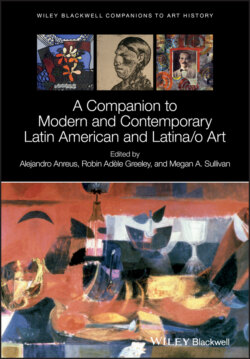Читать книгу A Companion to Modern and Contemporary Latin American and Latina/o Art - Группа авторов - Страница 28
1.4 Photography
ОглавлениеThe Mexican Revolution was intensely and immensely photographable, and legions of photojournalists grabbed every possible image of epic battles, street demonstrations, election events, portraits of the powerful and of the powerless, and scapes of cities and the countryside in full, violent stride toward capitalist modernization. These images were sold to the print media and to the postcard industry, flooding Mexico and the image‐hungry world with photodocuments of the first major political upheaval of the twentieth century (Debroise 2001; Folgarait 1998; Gabara 2008; Mraz 2012; Noble 2010; and Tejada 2009).
These photographs hold great value as documents, trusted as transparent registers of true events. Agustín Víctor Casasola and his brothers, in particular, established a brisk business in this trade, leaving us a comprehensive archive for a lifetime of study. They also founded an agency of “Photographic Information.” That these two terms were seen as inextricably linked is my point here. But, of course, these photographs are anything but innocent, contrived as any other artwork through cropping the initial exposure and darkroom magic as manipulative as today's digital effects. This we take for granted, and we can analyze their formal qualities as deeply as those of a painting. The extra ingredient of motivation for crafting photographs was precisely the market, much larger and more demanding than for any other medium of the time, insisting on seeing Emiliano Zapata posed just so, and marveling at seeing as many dead bodies as possible on the battlefield.
Because photography's manifest promise of truth, especially in its film and chemical period, has to be held in tension with its loaded craft, this medium is perhaps the most challenging in terms of historicizing it and yet, at once, trying to pry it loose from too tight a grip by that context. It is the photographic experience of history that matters most, and the Mexican photographers exploited this potential.
The important role played by Manuel Álvarez Bravo (1902–2002) is as an explicitly “artistic” photographer, composing with great care and then applying his considerable printing skills. He is best known for images of dreamlike, quasisurreal qualities, highly staged as poetic evocations, such as La buena fama durmiendo (Good Reputation Sleeping) and Parábola óptica (Optical Parable), but also for the immediate documentary value of Obrero en huelga, asesinado (Striking Worker, Assassinated). But even this spontaneous photograph offers deeply resonating meaning through its design as realized in the printing process.
The Italian‐born Tina Modotti (1896–1942) traveled to Mexico with the American photographer Edward Weston as his student and model, where she met Bravo and the mural painters, and was generally absorbed into Mexican matters of artistic style and leftist politics. She was initially involved in the style of the Estridentistas, a group of writers and visual artists devoted to formalist experiments derived from European cubist/futurist movements. The celebration of angular compositions, urban consciousness, and movement and energy for its own sake allegedly countered the nativist and folkloristic mural painters, although there was much conversation and collaboration between these two camps.9 That Modotti herself gradually moved into leftist politics and imagery suggests that that division was permeable. Her photographs became those of workers in massed demonstrations, workers reading newspapers, workers' hands resting on tools, and hammers and sickles crossed in formation. A devoted worker in the ranks of Mexican communism, her work can be read too easily as a transparent carrier of ideology.
The photography of Nacho López (1923–1986) is noted for its alleged slice‐of‐life approach (Mraz 2003). He roamed the streets of Mexico City, capturing its residents in their candid behavior, with an almost sociological attention to the dark underside of metropolitan life. This is a perverse claim, however, as it is also known that he staged some of these scenes with actors, manipulating the reactions of unaware bystanders. Thus, the documentary role innocently assigned to photography becomes loaded in the extreme in the hands of López and unsettles our expectations of what this medium can and should perform.
The works of Lola Álvarez Bravo (1907–1993), one‐time wife of Manuel, and of Graciela Iturbide (b. 1942) are notable for their combination of straightforward depictions of people and places with a sometimes surreal twist. Their focus is on people, especially faces and bodies, especially of women. Iturbide, in particular, promotes a feminist vision of women's situations and behaviors. Her images of life along the Mexican‐American border touch on the contested and unresolved tensions between/among those cultures. Probably her best known photograph is Mujer a&c.acute;ngel (Angel Woman), of 1979, showing a single indigenous woman from the back, hair and full skirt flowing backward as she strides purposefully into the expanses of the Sonoran desert carrying a boombox in her right hand, but somehow held back by a strap or rope she holds in her left hand.
As she moves from the shade into the sun, does she hear Mexican or American music, or none at all? Does she belong to others or to herself alone? Does she represent a vanishing culture or one morphing into unpredictable form? Does she know that her image is being captured and is therefore posing, or not? Are we following her or being left behind? The purpose of all these questions, which I do see as asked by the image, is to suggest that they are unanswerable because the possible answers are on opposite sides of a divide, of a border as obvious as the one between the shade she is leaving and the light she is entering, and the suggestive one of the US–Mexico border. But both kinds of borders are being crossed here, permeated by a strong will and by historical changes of vast dimensions.
